
Since joining the agency in August 1990, Tim Flores has spent the better part of his career at the Ames Research Center in Northern California. Presently, he is one of an elite group of NASA project managers enrolled in a System Design and Management program at the Massachusetts Institute of Technology (MIT).
We caught up with Tim last December at an APPL Knowledge Sharing Meeting in San Francisco. He flew in from Cambridge for the two-day conference and had to rush back immediately afterwards to prepare for end-of-semester finals. Despite his hectic schedule, he seems relaxed and pleased to try and be everywhere at once.
What motivated you to enter the MIT program at this point in your career?
I love learning. By learning I mean both professional and self-development. Before I came to MIT, I was constantly trying to learn more about project management and how to be a better leader. In a way, it was like they invented this program for me. I was trying to do it on my own, but couldn’t find time to go to school.
Was it difficult to go back to school after being out for more than a decade?
The difficult part was I forgot the time commitment involved to study full time. But I got used to that again pretty quickly. I didn’t have much choice.
I would expect the project managers enrolled in this program are all academically inclined — great students when they were in college. Was that a prerequisite?
It’s funny, I don’t think of myself as academically inclined. In high school I could have easily been voted ‘Least Likely to Succeed’ in my class.
Probably not “least likely.”
You didn’t know me in high school.
Okay, but there must have been some change in you at some point. Few people go from being ‘Least Likely to Succeed’ in his class to being in an MIT graduate program.
I changed a lot when I went into the Army. I got some discipline and realized the life I was leading wasn’t what I wanted.
How did you go about changing yourself?
I started by doing little things for self-confidence, saying things to myself like, ‘Today, or this week, I’m going to speak in front of a group if I get the chance.’ It was mostly about holding my head high and believing in myself.
How did you become a successful project manager?
I’m very driven. I think all successful project managers are. You’ve got a lot of responsibility and it can be overwhelming at times. No one else is going to drive you, and people are looking to you for leadership.
Was there a turning point in your career at NASA when upper management decided you were someone to start grooming for a leadership position?
Probably the single biggest event in my career was in 1997 when I was a member of the Tiger Team in the 12-foot pressure wind tunnel. If the Wind Tunnel was going to be successful, we knew we needed to put together a better training program than what we were currently offering. I took over the training with very little time to get it done. I had to be very careful in conveying that the earlier training wasn’t done well. I got them to accept that, and we ran the training for 6 weeks with more than 100 people involved. That was a pretty big deal because no one had attempted such an ambitious training program in such a short time frame. In the end we accomplished way more than we ever thought we could. That was probably the point at which people began to notice me.
At MIT you’ve met a lot of other successful project managers. What’s the biggest difference between managing a project at NASA, as opposed to managing one in private industry?
At NASA we have a lot of programs where it’s one strike and you’re out. You can’t afford to make a mistake in that environment. You’ve got to be very meticulous about the details you look at and the way you review things. In private industry, depending on the size of the company, you may or may not have process guidelines to follow. For example, a mid-size software company I know of, does not do risk management at all. They deal with what they can when they can and don’t spend any time with such things as fault trees or other such strategies.
Did you ever feel like a fish out of water with these other project managers from private industry?
At first I found myself a lot of times converting things in class. I thought, ‘Okay, how do I convert this principle to the way government does things?’ Eventually, I relaxed and found myself thinking it’s not that different really. In government there’s sometimes more bureaucracy to deal with but the value of the process is the same. I think it comes from the fact that the agency is very much in the eye of the public. We like to think of ourselves as setting the standards so we tend to be very meticulous and sometimes over-constrained.
Isn’t bureaucracy a huge obstacle?
I tend to think that it’s the end results that are most important. When you achieve results in government, it doesn’t always matter how you got there. I think the government does allow their project managers to be creative. When they’re achieving results and they’re doing it safely, the ability not to play by the rules and be creative is there.
What do you think will be the biggest difference in how you manage after you finish the MIT program?
Hopefully, being creative at using the new tools I’ve learned. My tool bag is going to be full, just full. One of the first things I want to do is start separating out those tools to determine which ones are appropriate in what situations.
Can you offer an example of how you would use one these tools?
Well, one example would be in trying to understand what the problem is you must solve. A lot of times you assume the problem posed to you is the correct one. Sometimes the customer doesn’t know exactly what they want. That may require taking steps backwards to understand what the customer’s needs are. Imagine a testing situation: you set everything up in advance to solve the problem you thought it was, and then you find out you have to make many adaptations to solve what the real problem is. By spending more time questioning the customer early on, that’s a better use of your time and theirs. The key is asking the right questions early.
Is persuading a customer of what they want a common problem?
More often it’s persuading your team, getting them to see the big picture, and then conveying the importance of customer satisfaction. You always have a customer whether it’s your direct manager, the public or someone else. One of the things I try to do in situations like this is get people to see the ‘Big Picture.’ You try to get them to understand the objectives of the entire program, the wider context factors for the agency or the Center, the unique constraints we’re operating under — that sort of thing. You convey that information so that hopefully they understand your decisions. If they understand why I made a decision, it’s more likely they’ll buy into the decision.
What tools do you use to do this?
Communication is the big one. Being able to talk to people in a non-threatening way and explain why you’re making the decisions you are making and also by making them feel that their opinion counts. When you have dissension in the ranks that’s always dangerous. Success depends on a team effort. I’ve always tried to stave off dissension, so I will take the time to sit down and explain to anyone the decisions I’m making when they don’t understand. They may not always agree with me, but they appreciate the effort I’m making and that matters in reinforcing that we’re a team and we all need to be aware of what’s going on and why.
So what are your plans once you finish at MIT and return to NASA?
I want to lead agency programs. In the future I hope there will be opportunities to step up as one of NASA’s leaders. That’s what I’d like most.










